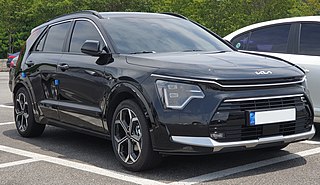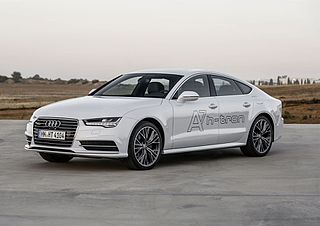
The Hyundai Motor Group is a South Korean chaebol headquartered in Seoul, South Korea. The largest member of the chaebol, Hyundai Motor Company, has a controlling stake in Kia, and they are the largest and second largest car manufacturers in the country respectively.

The Hyundai Tucson is a compact crossover SUV (C-segment) produced by the South Korean manufacturer Hyundai since 2004. In the brand's lineup, the Tucson is positioned below the Santa Fe, and above the Kona and Creta. It is named after the city of Tucson, Arizona. The second-generation model has been marketed as the Hyundai ix35 in several markets, including Europe, Australia and China, before reverting to Tucson for the third-generation.

The Hyundai Pony, is a small rear wheel drive automobile produced by the South Korean manufacturer Hyundai from 1975 until 1990. The Pony was South Korea's first mass-produced and exported car. The Pony nameplate remained in use until 2000 on some export versions of the Hyundai Excel and Accent.

A fuel cell vehicle (FCV) or fuel cell electric vehicle (FCEV) is an electric vehicle that uses a fuel cell, sometimes in combination with a small battery or supercapacitor, to power its onboard electric motor. Fuel cells in vehicles generate electricity generally using oxygen from the air and compressed hydrogen. Most fuel cell vehicles are classified as zero-emissions vehicles that emit only water and heat. As compared with internal combustion vehicles, hydrogen vehicles centralize pollutants at the site of the hydrogen production, where hydrogen is typically derived from reformed natural gas. Transporting and storing hydrogen may also create pollutants.

The Honda Clarity is a nameplate used by Honda on alternative fuel vehicles. It was initially used only on hydrogen fuel-cell electric vehicles such as the 2008 Honda FCX Clarity, but in 2017 the nameplate was expanded to include the battery-electric Honda Clarity Electric and the plug-in hybrid electric Honda Clarity Plug-in Hybrid, in addition to the next generation Honda Clarity Fuel Cell. Clarity production ended in August 2021 with US leases for the fuel cell variant continuing through to 2022.
A hybrid train is a locomotive, railcar or train that uses an onboard rechargeable energy storage system (RESS), placed between the power source and the traction transmission system connected to the wheels. Since most diesel locomotives are diesel-electric, they have all the components of a series hybrid transmission except the storage battery, making this a relatively simple prospect.
The following outline is provided as an overview of and topical guide to automobiles:
The Hyundai California Design (HCD) concept vehicles were designed at the Hyundai Motor Company's California studio for the North American market. The first concept vehicle, the HCD-1, was a targa-top sports car aimed at the Mazda Miata, and was unveiled in 1992, but was never produced. Other HCD-branded concepts have previewed production models; for example, the HCD-14 Genesis was a large sedan which eventually reached production as the second-generation Hyundai Genesis.

The Mazda Premacy Hydrogen RE Hybrid or Mazda5 Hydrogen RE Hybrid was a hydrogen powered hybrid car produced by Mazda. Later models were also called the Mazda Hydrogen RE Plug in Hybrid. The first car was unveiled in 2005, with an improved version shown at the 2007 Tokyo Motor Show. Mazda planned for the car to enter production and leased a few cars to end users in 2009 in 2010.

The Hyundai Blue-Will is a plug-in petrol-electric hybrid concept compact car designed by the South Korean car manufacturer Hyundai Motor Company. The vehicle was debuted at the 2009 Seoul Motor Show in South Korea.
Rimac Automobili is a Croatian car manufacturer headquartered in Sveta Nedelja, Croatia, that develops and produces electric sports cars, drivetrains and battery systems. The company was founded in 2009 by Mate Rimac. Rimac Automobili's first model, the Concept One, was the world's fastest production electric vehicle. While manufacturing and marketing high-performance vehicles under its own brand, Rimac also develops and produces battery packs, drivetrain systems, and vehicles for other companies. The Applus+ IDIADA Volar-E is an example of a product developed for another company. During the 88th Geneva International Motor Show in March 2018, the company unveiled its second model, the Rimac Nevera.

In automotive engineering, the drivetrain is the group of components of a motor vehicle that deliver power to the drive wheels. This excludes the engine or motor that generates the power.

The Kia Niro is a compact crossover SUV (C-segment) manufactured by Kia since 2016. It is an electrification-focused vehicle, offering three versions: hybrid, plug-in hybrid and battery electric variants.

The Hyundai Ioniq is a compact five-door liftback manufactured and marketed by Hyundai. The nameplate Ioniq is a portmanteau of ion and unique. It is marketed as the first automobile to be offered without a standard internal combustion engine, but rather sold in hybrid, plug-in hybrid, and all-electric variants.

The Audi A7 h-tron quattro is a concept hydrogen/electric plug-in hybrid automobile, released by Audi AG in the 2014 Los Angeles Auto Show. The A7 h-tron quattro keeps the same recognizable features of the other A7 variants, but typically has "A7 h-tron" decals.

The BMW i4 is a battery electric compact executive car produced by BMW since 2021. It adopts a five-door liftback body style and is marketed as a four-door coupé. The initial concept version, named BMW i Vision Dynamics, debuted at the 2017 Frankfurt Motor Show. It is the fifth BMW i sub-brand model, and is sold in several variants at different performance levels, including the first battery-electric variant by BMW's motorsport division. The production version was revealed in March 2021 and went on sale in November 2021.

The ENC Axess is a line of low-floor transit buses available in 35' and 40' nominal lengths manufactured by ENC in Riverside, California starting from 2003. In addition to the different available lengths, the buses are sold with a variety of prime movers, ranging from conventional diesel, LNG/CNG combustion engines, diesel-electric hybrid and hydrogen fuel cell with a traction motor.
This is a list of concept vehicles made by Toyota from the years 2020–2029.
PE System is the driving device for electric vehicles.

The Hyundai N Vision 74 is a concept car developed by Hyundai. The sporty car was unveiled at N Day 2022, an event organized by the Hyundai N performance division in mid-July 2022 at Busan, South Korea, alongside the Hyundai RN22e concept based on the Hyundai Ioniq 6 electric vehicle. The N Vision 74 is a rear-wheel-drive coupe driven by two electric traction motors, both on the rear axle; power is provided by both a storage battery and a hydrogen fuel cell.














